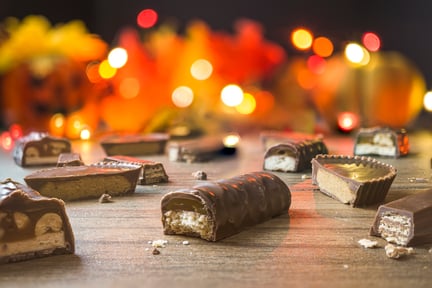 Halloween is just around the corner, and we all know what that means: candy… almost everywhere! While candy is a tasty treat, as with most things, too much can have its consequences. Most candies provide very little nutritional value and are full of added sugars, one of the nutrients the 2020-2025 Dietary Guidelines for Americans suggest most individuals limit in their diet. Added sugars provide calories (4 calories/1 gram of sugar) and when consumed in excess, can result in dental cavities and difficulty achieving a healthy dietary pattern within an individual's caloric limits, which may result in unintentional weight gain. However, this doesn’t mean you shouldn’t or can’t indulge in foods containing added sugars, like Halloween candy! Instead, the Dietary Guidelines for Americans provides a recommended daily limit for added sugars, advising individuals to consume no more than 10% of their daily caloric intake from added sugars. For perspective, someone who consumes 2,000 calories/day, should consume no more than 200 calories from added sugars, or less than 50 grams of added sugars each day. This year, be mindful of how many grams of added sugars you’re consuming from Halloween candy and try to keep your total daily added sugar intake below what is recommended based on your recommended caloric intake.
Halloween is just around the corner, and we all know what that means: candy… almost everywhere! While candy is a tasty treat, as with most things, too much can have its consequences. Most candies provide very little nutritional value and are full of added sugars, one of the nutrients the 2020-2025 Dietary Guidelines for Americans suggest most individuals limit in their diet. Added sugars provide calories (4 calories/1 gram of sugar) and when consumed in excess, can result in dental cavities and difficulty achieving a healthy dietary pattern within an individual's caloric limits, which may result in unintentional weight gain. However, this doesn’t mean you shouldn’t or can’t indulge in foods containing added sugars, like Halloween candy! Instead, the Dietary Guidelines for Americans provides a recommended daily limit for added sugars, advising individuals to consume no more than 10% of their daily caloric intake from added sugars. For perspective, someone who consumes 2,000 calories/day, should consume no more than 200 calories from added sugars, or less than 50 grams of added sugars each day. This year, be mindful of how many grams of added sugars you’re consuming from Halloween candy and try to keep your total daily added sugar intake below what is recommended based on your recommended caloric intake.
Curious about how many grams of added sugars your favorite Halloween Candy has?
- Reese’s Cup® (3 miniature cups): 13 grams added sugars
- Kit Kat® (4 mini/fun size bars): 17 grams added sugars
- Brach’s® Candy Corn (12 pieces): 22 grams added sugars
- Twizzler® (3 fun size pieces): 12 grams added sugars
- M&Ms ® (2 fun size packs): 16 grams added sugars
- Twixx® (3 mini/fun size bars): 8 grams added sugars
- Crunch® (2 mini/fun size bars): 14 grams added sugars
- Butterfinger ® (2 mini/fun size bars): 14 grams added sugars
- Milkyway ® (4 mini/fun size bars): 19 grams added sugars
- Snickers ® (3 mini/fun size bars): 13 grams added sugars
- Hersheys® (2 mini/fun size bars): 13 grams added sugars

